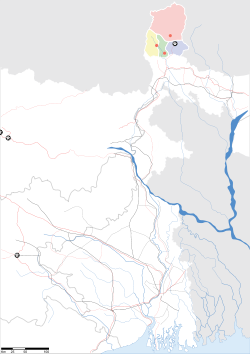Shortsword (1907.47.4)
 Location of Sikkim in IndiaShort-sword from Sikkim, Asia. Owned by Rajkumar Sidkong Tulku. Given to the Museum in 1907.
Location of Sikkim in IndiaShort-sword from Sikkim, Asia. Owned by Rajkumar Sidkong Tulku. Given to the Museum in 1907.
This short-sword, presented to the Museum over a century ago, originally came from the Lepcha people of Sikkim, a state in the Himalaya Mountains. The Lepcha people are of a Tibetan and Buddhist origin. This explains the sword's modest form - warfare was uncommon and generally practised with a bow and arrow - and its rich symbolism.
The blade sits in an unusual one-sided wooden scabbard, secured by two simple brass bands. On the blade near the handle there is an incised mark of two dotted semi-circles, which symbolise the eyes of the all-knowing and all-seeing Buddha. The hilt and the scabbard are decorated with small silver lotus flowers, denoting an individual's potential to achieve enlightenment, whatever the conditions of his birth.





